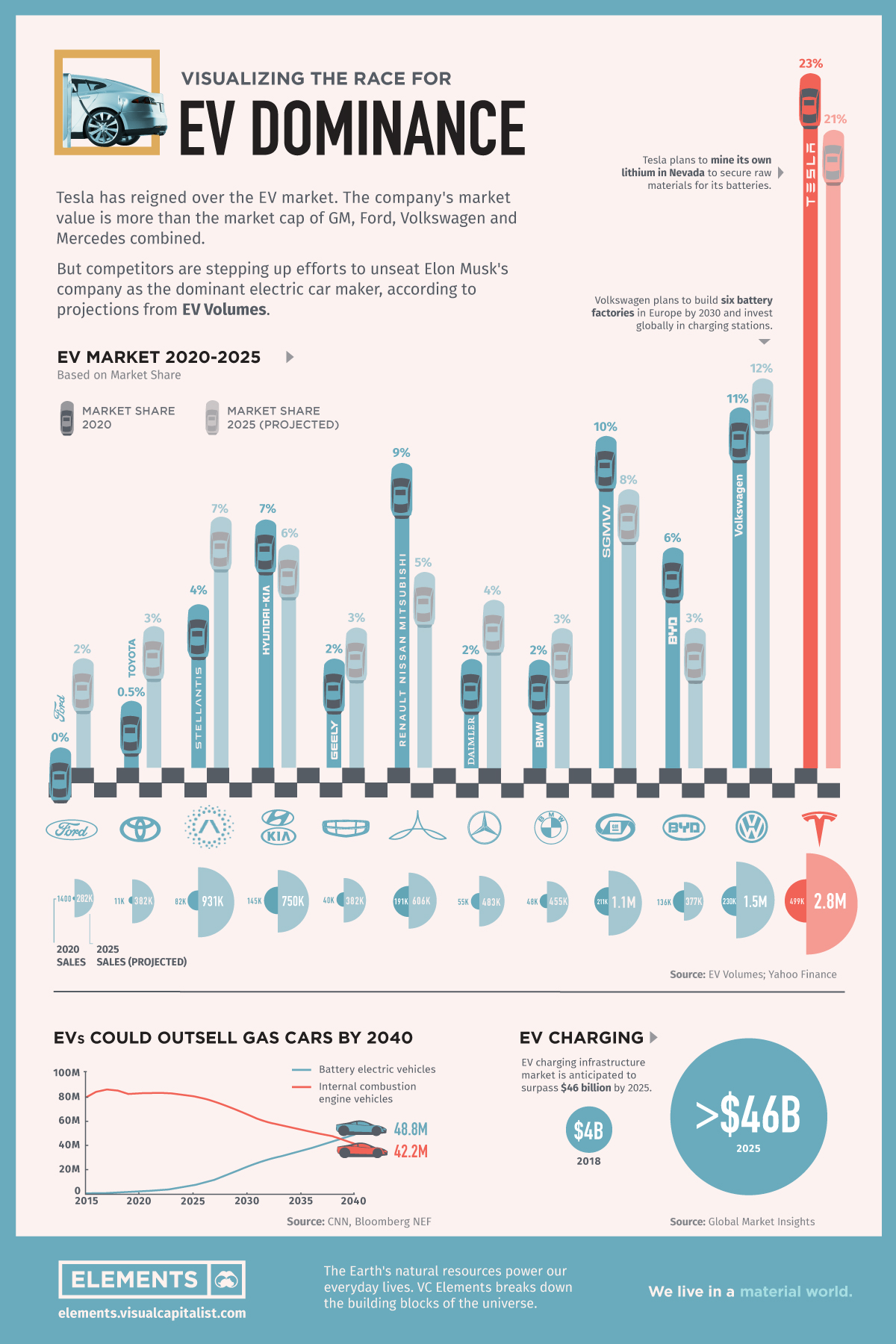Electric car companies: Visualizing the race for EV dominance

Electric Car Companies: Eating Tesla’s Dust
Tesla has reigned supreme among electric car companies, ever since it first released the Roadster back in 2008.
The California-based company headed by Elon Musk ended 2020 with 23% of the EV market and recently became the first automaker to hit a $1 trillion market capitalization. However, competitors like Volkswagen hope to accelerate their own EV efforts to unseat Musk’s company as the dominant manufacturer.
This graphic based on data from EV Volumes compares Tesla and other top carmakers’ positions today—from an all-electric perspective—and gives market share projections for 2025.
Auto Majors Playing Catch-up
According to Wood Mackenzie, Volkswagen will become the largest manufacturer of EVs before 2030. In order to achieve this, the world’s second-biggest carmaker is in talks with suppliers to secure direct access to the raw materials for batteries.
It also plans to build six battery factories in Europe by 2030 and to invest globally in charging stations. Still, according to EV Volumes projections, by 2025 the German company is forecasted to have only 12% of the market versus Tesla’s 21%.

Other auto giants are following the same track towards EV adoption.
GM, the largest U.S. automaker, wants to stop selling fuel-burning cars by 2035. The company is making a big push into pure electric vehicles, with more than 30 new models expected by 2025.
Meanwhile, Ford expects 40% of its vehicles sold to be electric by the year 2030. The American carmaker has laid out plans to invest tens of billions of dollars in electric and autonomous vehicle efforts in the coming years.
Tesla’s Brand: A Secret Weapon
When it comes to electric car company brand awareness in the marketplace, Tesla still surpasses all others. In fact, more than one-fourth of shoppers who are considering an EV said Tesla is their top choice.
“They’ve done a wonderful job at presenting themselves as the innovative leader of electric vehicles and therefore, this is translating high awareness among consumers…”
—Rachelle Petusky, Research at Cox Automotive Mobility Group
Tesla recently surpassed Audi as the fourth-largest luxury car brand in the United States in 2020. It is now just behind BMW, Lexus, and Mercedes-Benz.
The Dominance of Electric Car Companies by 2040
BloombergNEF expects annual passenger EV sales to reach 13 million in 2025, 28 million in 2030, and 48 million by 2040, outselling gasoline and diesel models (42 million).
As the EV market continues to grow globally, competitors hope to take a run at Tesla’s lead—or at least stay in the race.
(This article first appeared in the Visual Capitalist Elements)
More News
{{ commodity.name }}
{{ post.title }}
{{ post.date }}



2 Comments
Deno
The data used in this graph is deeply flawed.
For the start, global BEV market share of Tesla was 21.5% in Q1-Q3 2021, whereas the chart predicts this share for 2025. But OK, that’s possible if not probable.
If the current trends persist, VW group should sell 1.5 million BEVs in 2023, not in 2025. But again, it’s possible that their growth will slow and 1.5 M mark reached two years later. Not likely, but possible.
What’s not possible is the BYD prediction.
BYD is ramping up production at a phenomenal rate. It has sold 41,000 BEVs in October, which means that their sales are bound to exceed 500,000 in 2022. 377k prediction for 2025 is ridiculous.
Bruno Venditti
Thanks Deno, the graphic is based on projections by EV-Volumes.